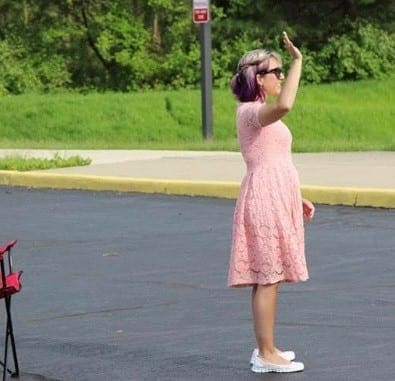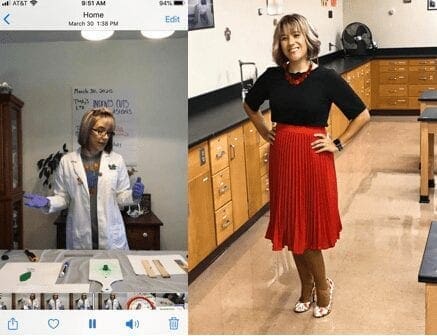Pandemic Distance Learning? I forget, but wasn’t that covered in teacher education?
Maybe one day in the near future, but prior to the aberration that is 2020, the answer is a definitive no.
Mobile tech and capabilities served as a nice bonus districts could tout when talking about their respective schools.
It’s not an outright necessity for learning. But that’s no longer the case.
Shawnna Holt, a Wheeling native and teacher at Pickerington Central High School is, nearing 20 years in education.
She received her bachelor’s degree from Marshall and later her master’s from Ohio U.
Her home district long ago embraced the added benefits of one-to-one technology with mobile devices for the students.
So, when the pandemic hit and schools were forced to adjust rapidly to a changing environment, Holt was better positioned than most.
She admits though, even with those advantages, difficulties arose. Those difficulties extend beyond lesson plans.
It wasn’t an easy transition for her students.
Some excelled, no longer bound by the in-class restrictions and structure. Some felt more comfortable opening up and asking questions.
And yet, some, needed that structure and streamlining, slipped from their usual levels of success.
It was a learning experience all around, one that Holt has taken to heart.
With the prospects of how the upcoming school year is going to go still up in the air, she’s preparing for all eventualities.
The reigning Central High School teacher of the year is making it her mission to ensure her students have the best experience possible.
Safe to say the last few months of 2019-20 weren’t covered during teacher ed and student teaching. How hard was it to make such a wholesale shift on the fly? Looking back, anything you wish you could have done differently?
I would say this depended on whether districts were prepared with technology. I am lucky to work in a school district that has one-to-one technology (every student had a device) for 5th grade to 12th grade. We also had hotspots for WiFi purchased and available for students without WiFi. I think we all did the best we could under the short notice. School districts who did not and still do not have these types of supports I know really struggled to provide authentic learning experiences for students. I was very grateful to have students with things in place. It was really stressful and emotional for a lot of us, because most teachers will agree that there is no substitute for getting to know and see your students face to face. If we do have to go to some distance learning, I do think our district is trying to prepare ahead so we can do the best job possible. I wish I had known some of the digital tools that were available. I would have definitely used them! There are great things out there like Jamboard, Screencastify, Flipgrid, and Pear Deck that I had not used before but plan on using next year. I have spent time this summer working on professional development on blended learning to use these tools better in the future so that what I give them is more engaging. It was a lot of unexpected challenges all at once.
Teaching high school students, did any reach out or express their thoughts, positive or negative, about the remote learning?
Yes. I got lots of emails! What I liked about that was that I honestly think it strengthened some of my communication skills with students and their parents. I also mailed my students positive notes through the regular mail, which some of them said helped a lot and made them feel less disconnected. High school students sometimes get a bad reputation as being indifferent or lazy when stuff like this happens. I would say the thing I was most proud of was how hard my students worked despite the changes. I did have some negative, but it really was more directed to them missing seeing and interacting with their friends and teachers. Having seniors, a lot of them were sad about not getting to do certain rites of passage that come with that. However, I personally really enjoyed the way we handled our graduation; we did a drive through ceremony. Each student who participated got individual attention we normally can’t provide for ceremony and it was so fun. Many families came with their cars all decorated; some even borrowed or rented larger vehicles, and it was such a cool way to get to say goodbye to my graduates!

What advantages/disadvantages did you find when trying to teach that way?
I teach all different levels of high schoolers. This whole experience really magnified for me the differences in their learning styles. I had students who did not do well in the regular setting do better with online learning because they could do it on a flexible schedule. It also took away some of the peer anxiety; for example, they could ask questions directly to me or get one on one help and not worry about everyone in class around them. It is really hard to get students who have not always been successful at school to get past that when we are in person because they think everyone is going to judge them if they ask questions or need help. On the flip side, some students who flourished in the classroom setting fell apart without the structure of the day and the face-to-face interaction. It was really hard for them to adapt as they did best as learners with a teacher there to help them. Some were just emotionally overwhelmed because of all the changes. No matter what happens going forward, I think we all realized how important school as a whole is to our communities. As we plan, we need to consider how important the social supports of school are to students and that we have to address that. We also need to make support available for parents, as it is really hard for some of them to navigate all the tech, lessons, and changes to support their kids.
Given the uncertainty surrounding the recommendations of the state for the next school year, are you having to plan for multiple possibilities?
Yes. My district has and is offering professional development to help us improve no matter what scenario we have. Our initial plan is to go back as normal with health and safety precautions in place. We are waiting to see what the Ohio Department of Education establishes as the back to school guidelines as well as considering community feedback before finalizing plans. As a teacher and a parent, I know there probably is not going to be an amazing solution that all teachers, staff, and parents agree with, but I do think schools are trying their best. I think that the things I learn from this situation can be used no matter what happens. My main concern is space and safety at this point. Both high schools in our town are at enrollments of 1800 plus kids, and it already had seemed the building was bursting at the seams with everyone there. It’s a little daunting to think about how we are going to safely manage everyone when we return to using those shared spaces.

You teach a subject where observation and hands-on experiences are key to understanding. How hard has that been adjusting and not being able to provide those in-person lessons and examples?
Obviously, it would be best to do all labs in person, so my students get hands-on experience. I teach forensic science, and we do a lot of hands-on labs. I adjusted by doing online videos and demonstrations so that the students could see the experiments and predict the results. It wasn’t perfect, and I definitely think there are some improvements I could make, but they at least got the ideas introduced to them and visual examples of the labs.







